Fountain Grass Turning White: My Fountain Grass Is Bleaching Out


The sway of gently arching foliage and swish that follows as they rustle in the wind are treats for the eye and the provision of the elegant fountain grass. There are many varieties of Pennisetum, with a wide range of sizes and foliage colors. Near the end of the season, you may find your fountain grass turning white, bleached, and unappealing. What is happening? Is there some sort of terrible fountain grass problem? Rest your mind, the plant is doing quite fine. Bleaching is a natural part of the plant’s life cycle.
White Fountain Grass Foliage
Fountain grasses are perennial plants that form dense clumps of airy foliage. The grasses are warm-season plants, which means that they go dormant in winter. Fountain grass problems are few and the plants are tolerant when established. They are hardy, low-maintenance plants for the savvy gardener. White fountain grass, or Pennisetum setaceum ‘Alba,’ is an attractive form with slender green foliage and delicate nodding white inflorescences. Contrary to the name, it should not have white or even silvery leaves, but the name instead refers to the flower hue. White fountain grass foliage arises near the end of the season when cold temperatures begin to arrive. The change in color signals the arrival of the plant’s dormancy. Usually, the blades start to yellow and fade, and eventually, the tips turn white and brittle. A fountain grass turning white is the plant’s response to the cool temperatures as it readies itself to slumber until warm season temperatures return. Any of the other varieties of fountain grass will experience the same bleaching and die back for winter.
Fountain Grass is Bleaching Out
Fountain grasses thrive in USDA zones 5 to 9. In hotter climates, it may get burned by harsh sun rays and lose color on the tips of the leaf blades. In colder climates, the plant is an annual and will begin dying back in cold weather. If you wish to preserve your plant in northern climes, pot it up and move it indoors for the winter. Plants that are grown in hot climates benefit from protection from the midday sun. The foliage will perform best in light shade. If fountain grass is bleaching out in any other condition, it is likely just a seasonal display and should be enjoyed. Should the color bother you, however, it is okay to cut the foliage back to several inches (7.5 cm.) above the ground in late fall and wait for the new blades to come in when spring arrives.
Fountain Grass Problems
Fountain grass is relatively resistant to pests and disease. Some plants may develop foliar problems with rust fungus and slugs and snails may occasionally take bites out of the foliage but overall, it is a hardy, rugged plant with few issues. The seed heads produce prolifically, which can become a problem in some climates where they readily propagate and spread. Cutting off the inflorescences before they produce seeds should reduce the issue. Fountain grass is a reliable plant with graceful appeal and several seasons of interest, so don’t worry about the faded foliage and focus on the next spectacular season.
Gardening tips, videos, info and more delivered right to your inbox!
Sign up for the Gardening Know How newsletter today and receive a free download of our most popular eBook "How to Grow Delicious Tomatoes."

Bonnie Grant is a professional landscaper with a Certification in Urban Gardening. She has been gardening and writing for 15 years. A former professional chef, she has a passion for edible landscaping.
-
 Want a Backyard Mini Orchard? Create Your Own Container Orchard
Want a Backyard Mini Orchard? Create Your Own Container OrchardEasier to care for in small spaces, a backyard mini-orchard makes sense for busy gardeners and juicy fruit is the reward.
By Teo Spengler
-
 Urban Beekeeping Guide: Top Tips For Raising Bees In The City
Urban Beekeeping Guide: Top Tips For Raising Bees In The CityUrban beekeeping can be a rewarding and appreciated pastime, but first be sure it’s legal in your city and learn the ropes of beekeeping.
By Mary Ellen Ellis
-
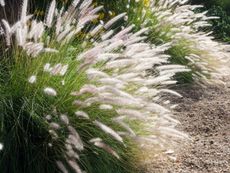 Fountain Grass Varieties – Learn About Popular Fountain Grass Plants
Fountain Grass Varieties – Learn About Popular Fountain Grass PlantsThere are many fountain grass cultivars. Hardiness and growing conditions can vary depending on variety. Click to learn more.
By Amy Grant
-
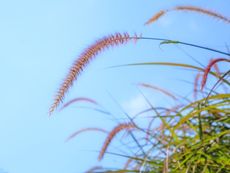 Red Fountain Grass Care – What Is Crimson Fountain Grass
Red Fountain Grass Care – What Is Crimson Fountain GrassRed fountain ornamental grass is a showy, clump forming grass with burgundy red leaves and feathery plumes of rosy purple blooms, also known as crimson fountain grass.
By Mary H. Dyer
-
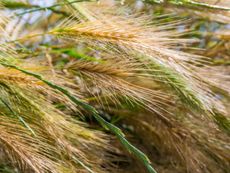 Little Honey Fountain Grass – How To Grow Pennisetum Little Honey
Little Honey Fountain Grass – How To Grow Pennisetum Little HoneyIf you want a showy, ornamental grass, you should try growing little honey fountain grass. Read on to learn more.
By Bonnie L. Grant
-
 Little Bunny Fountain Grass Care: Growing Little Bunny Fountain Grass
Little Bunny Fountain Grass Care: Growing Little Bunny Fountain GrassMost types of fountain grasses grow pretty large, making them unsuitable choices for small spaces. The miniature Little Bunny dwarf fountain grass, however, is perfect for tiny areas. Learn more about Little Bunny fountain grass in this article.
By Laura Miller
-
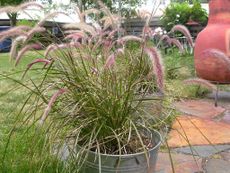 Fountain Grass Trimming – How To Treat Brown Tips On Fountain Grass
Fountain Grass Trimming – How To Treat Brown Tips On Fountain GrassFountain grass plants are easy to grow and generally unfussy, but occasional brown tips on fountain grass can be a clue to incorrect site conditions, cultural care or simply a natural process. There are several browning fountain grass causes, so click here for more info.
By Bonnie L. Grant
-
 Fertilizing Fountain Grass – When And What To Feed Ornamental Grasses
Fertilizing Fountain Grass – When And What To Feed Ornamental GrassesFountain grass feeding is a rare chore because ornamental grasses like these thrive in low fertility areas. However, let the appearance of the plant be your cue and fertilize only when color and leaf health are indicative of nutritional scarcity. Learn more here.
By Bonnie L. Grant
-
 Tips For Fountain Grass Pruning: Cutting Back Fountain Grass
Tips For Fountain Grass Pruning: Cutting Back Fountain GrassFountain grasses are a reliable and pretty addition to the home landscape, adding drama and height. But when do you prune fountain grass? In the fall, winter or in the spring? And how? This article will help.
By Heather Rhoades
-
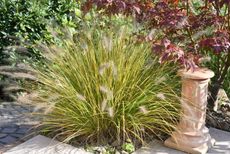 Tips For Care Of Fountain Grass
Tips For Care Of Fountain GrassFountain grass is a mound-forming ornamental grass and a garden favorite, as the care of fountain grass is easy. You can learn more about growing fountain grass in the article that follows.
By Nikki Tilley